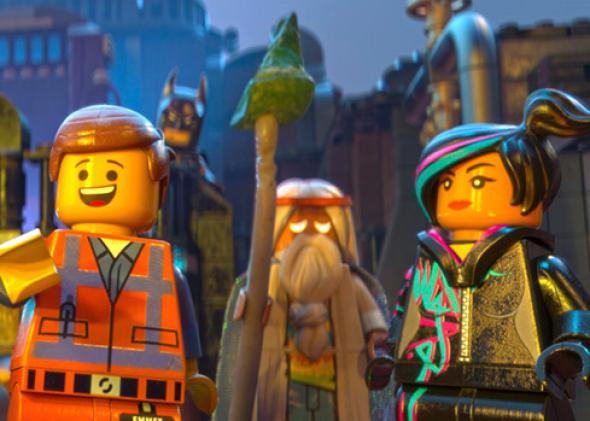The Lego Movie had so much going against it. First off, it’s a movie inspired by a system of interlocking plastic blocks. Second, it’s a branded entertainment—an ominous category if ever there was one, all but guaranteeing a clamorous action infomercial shoddily intercut with a formulaic “human” story. I’m going to level with you: I went in hoping at best for something intermittently amusing, not too visually and sonically assaultive, and over soon.
But Chris Miller and Philip Lord, the creators of Cloudy With a Chance of Meatballs and 21 Jump Street, along with the highly regarded but short-lived animated series Clone High, have gone and done it. They’ve made a clever, vividly imagined, consistently funny, eye-poppingly pretty and oddly profound movie … about Legos. Miller and Lord do not grovel before their corporate overlords, and at times even appear to be conveying the subversive message that, when it comes to Legos, less may be more (or at least that a random bucket of unsorted blocks may be preferable to a brand-new boxed set).
The Lego cosmos as envisioned in this story is divided between two sets of principles. On the one side, there’s order, conformity, and stasis, as embodied by the perfection-obsessed, freedom-stifling President Business (voice of Will Ferrell). On the other, there’s chaos, individuality, and change, represented by the rebel movement that’s attempting to find a mysterious lost object called the Piece of Resistance, which will stop President Business before he can unleash the Kragle, a weapon that threatens to freeze the dynamic Lego universe into a perfected but lifeless tableau.
But the majority of the inhabitants of the eternally-in-construction city of Bricksburg live their lives blissfully unaware of this ideological divide: They’re interchangeable molded-plastic working stiffs, square pegs in square holes. Squarest of all is Emmet Brickowski (voice of Chris Pratt), a go-along-to-get-along construction worker who’s naively psyched to repeat the same dull day over and over again, building the same brick towers while obediently bopping to the same state-mandated No. 1 pop song (Tegan and Sara’s irresistible ode to vacuity “Everything Is Awesome”) and buying the same overpriced cups of takeout coffee. (A running gag about the ever-rising price of that commodity is one of the movie’s many jabs at consumer culture.)
When Emmet accidentally comes into possession of a strange item that seems to come from outside the Lego universe, resistance member Wyldstyle (a sort of Goth biker-chick minifig voiced by Elizabeth Banks) becomes convinced that the thoroughly unremarkable Emmet is the Special—a long-awaited figure of prophecy, who will be “the most important, most interesting, greatest person of all time.” Half against his will—though he is, understandably, bewitched by the tough and glamorous Wyldstyle—Emmet gets swept up in the rebels’ plan to disarm the Kragle and take down President Business’s reign of spontaneity-crushing terror.
Joining Emmet and Wyldstyle on their mission are Vitruvius, a glowing-eyed wizard figure voiced by Morgan Freeman, whose dubious nuggets of wisdom and muttered expressions of annoyance are priceless sendups of the long Morgan Freeman-as-shaman voiceover tradition; the square-headed pink kitten Unikitty (voice of Alison Brie), whose bubbly optimism conceals a deep well of repressed rage; a blustering pirate figure (voice of Nick Offerman); and a chipper ’80s-era spaceman slightly dinged from wear (voice of Charlie Day). When he can drag himself away from his Star Wars buddies, they’re also joined by Wyldstyle’s boyfriend, Batman (voice of Will Arnett), hilariously conceived as a post-Christopher-Nolan “bad boy” bent on impressing the world with his death-metal songwriting and brooding cool.
But President Business—who, as the minifigs’ journey takes them through a sprawling Lego multiverse Emmet never knew existed, reveals himself as the even more diabolical Lord Business—has some fierce allies on his side, including the fearsome Bad Cop/Good Cop (voice of Liam Neeson), who enacts both sides of the familiar law enforcement dichotomy simply by rotating his head to alternate between scowling and happy expressions.
All this precisely orchestrated silliness unfolds against the background—or sometimes, given the crisp-looking 3-D, in the foreground—of a lovingly imagined, insanely detailed, and kaleidoscopically colorful universe made up entirely of Lego pieces. Nearly 4 million unique bricks were used in filming, and though the stop-motion animation is liberally augmented with computer effects (to a degree that it’s impossible to tell where one technique leaves off and another begins), there’s a chunky sense of real-world volume to the moving shapes and figures onscreen. There’s also a lot of Lego-based humor that you don’t have to be a 10-year-old collector to appreciate—gags, for example, about the inefficiency of those C-shaped claw hands, which can clutch only cylindrical foods like chicken legs or sausage links. The overall sensation (enhanced by Mark Mothersbaugh’s playful electronic score) is one of being whisked from one trippy Lego environment to the next—the trippiest of all being Unikitty’s homeland, a conflict-free pastel Shangri-La known, in what I’m going to wager will be the only Aristophanes reference in a toy-based movie this year, as “Cloud-Cuckoo Land.”
The last 20 minutes or so of The Lego Movie contain a big conceptual twist, one that threatens at first to drag down the zippy kinetic energy of the film’s first hour. But stay with it, because it’s in this perception-shifting last reel that the movie really sets itself apart, not just from most branded entertainment, but from most films for children, period. As Lord and Miller skillfully balance an impressive array of narrative and thematic spinning plates—order and chaos, adults and children, practicality and magic, the real and the imaginary—it becomes clear even if this anarchic celebration of the creative capacity of play centers around the struggles of one-and-a-half-inch-tall minifigures, it’s built on a distinctly human scale.
